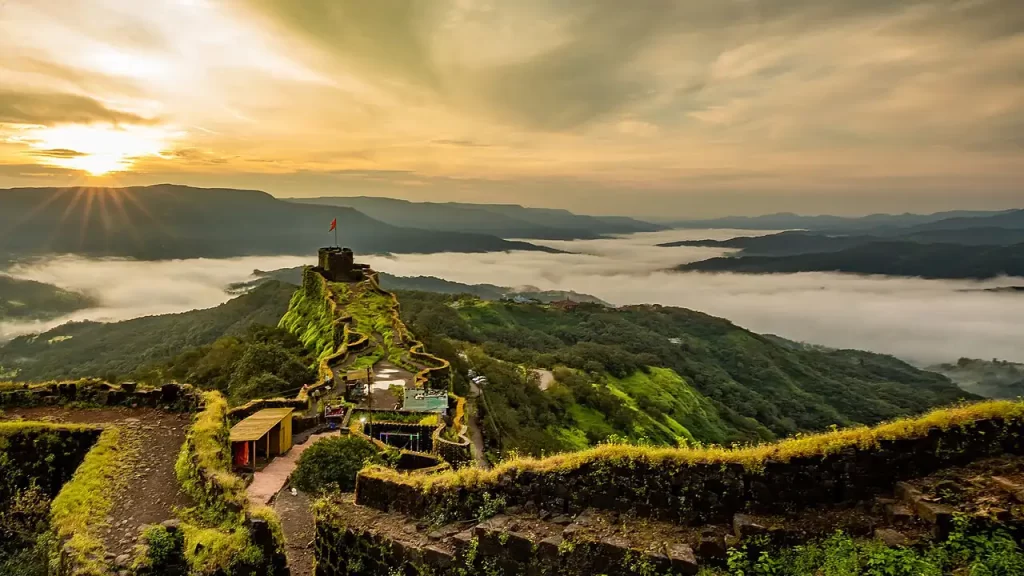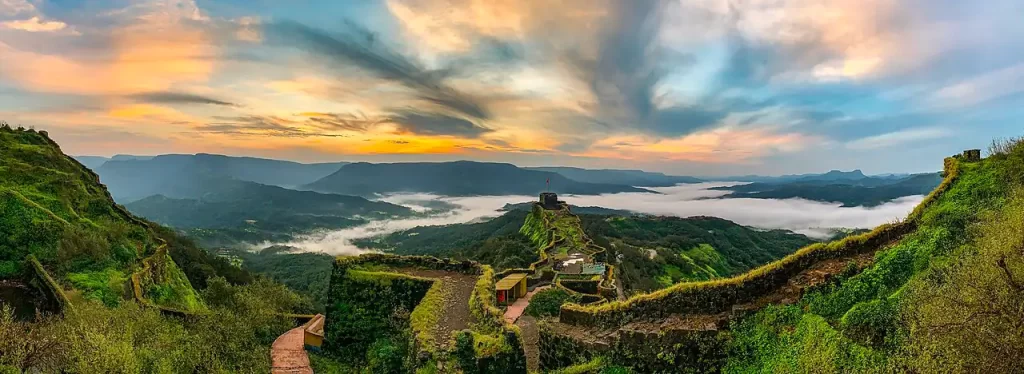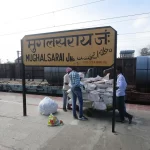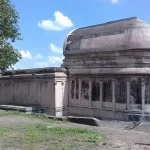“Ready to explore Satara? Book your trip today and dive into Maharashtra’s best-kept secret!”
🔴 Introduction: Satara – Where History Meets Natural Splendour
“Satara: A Crown of Forts, Flowers, and Timeless Tales”
Satara, a city cradled by the Sahyadri Mountains and kissed by the Krishna River, is a treasure trove of Maharashtra’s history, biodiversity, and cultural heritage. Known as the “Land of Seven Forts” (Sat-Tara), this city has witnessed the rise of the Maratha Empire, survived colonial annexation, and today thrives as a hub for nature lovers and history buffs. From the cascading Thoseghar Waterfalls to the UNESCO-listed Kaas Plateau, Satara offers a symphony of experiences.
In this guide, we’ll journey through Satara’s layered past, explore its architectural marvels, decode its vibrant culture, and provide actionable travel tips. Whether you’re trekking to Ajinkyatara Fort or savouring the famed Kandi Pedha, Satara promises unforgettable memories.

Satara – Maharashtra’s Crown of Heritage, Nature, and Resilience
“Where Forts Whisper History and Meadows Bloom in Monsoon Magic”
🟢 Detailed Introduction
🔘 Satara: A Historical and Geographical Jewel
Nestled at the foothills of the Sahyadri Mountains and flanked by the Krishna and Venna rivers, Satara is a city steeped in Maratha legacy and natural grandeur. Established in the 16th century as the capital of Chhatrapati Shahu I, heir to Chatrapati Shivaji’s Empire, Satara derives its name from the seven forts (Sat-Tara) encircling the city, including the iconic Ajinkyatara Fort. Known as the “Soldier’s City” for its contributions to India’s armed forces, Satara blends history with modernity, offering lush landscapes like the UNESCO-listed Kaas Plateau and vibrant cultural traditions.
Also Read
Jalna, Maharashtra – Where Marathwada Region’s History Meets Modernity
🔘 Historical Significance: From Maratha Glory to British Annexation
Satara’s history is a tapestry of valour and political intrigue. After Shivaji’s death in 1680, the city became a battleground for succession. Aurangzeb’s Mughals captured Ajinkyatara Fort in 1706, but it was reclaimed by Parshuram Pratinidhi, paving the way for Chhatrapati Shahu I’s coronation in 1708. The British annexed Satara in 1848 via the Doctrine of Lapse, ending its royal lineage. During the Quit India Movement, Satara became a hub for underground governance, showcasing its rebellious spirit.

🔘 Natural Splendour: Kaas Plateau and Waterfalls
The Kaas Plateau, a UNESCO World Heritage Site, transforms into a floral wonderland each monsoon (August–September), boasting 850+ species like pink balsams and blue utricularias. Nearby, Thoseghar Waterfalls cascade over 500 meters, while Vajrai Falls, India’s tallest plunge waterfall (560 meters), offers awe-inspiring views. For tranquility, Bamnoli on the Koyna River provides serene boat rides amid Sahyadri vistas.
🔘 Architectural Marvels: Forts and Step-wells
➸ Ajinkyatara Fort: A 11th-century stone sentinel with secret tunnels and a temple to Goddess Ajai. Ideal for sunrise treks.
➸ Sajjangad Fort: The final resting place of Saint Ramdas, blending military and spiritual architecture.
➸ Baramotichi Vihir: A 16th-century step-well near Limb village, adorned with intricate carvings.

🔘 Local Cuisine: A Gastronomic Journey
Satara’s culinary scene thrives on simplicity and tradition:
➸ Kandi Pedha: A milk-based sweet crafted at Shri Datta Snacks, using century-old techniques.
➸ Pithla-Bhakri: A rustic meal of chickpea flour curry with millet bread, best enjoyed at local eateries like Annapurna Bhojanalay.
➸ Masale Bhaat: Spiced rice dish served during festivals, available at street stalls near Ajinkyatara Fort.
Local Insight: “Our Kandi Pedha uses milk from nearby villages—no preservatives, just purity”, says Vikram Desai, a third-generation sweet-maker.
🔘 Accommodations: Where to Stay
➸ Budget: Hotel Satara Residency (₹1,000/night) near the bus stand offers clean rooms and local cuisine.
➸ Heritage: Prakash Palace (₹3,500/night), a restored Maratha-era mansion with antique décor.
➸ Luxury: Kaas Valley Resort (₹6,000/night), featuring eco-friendly cottages and guided nature walks.

🔘 Notable Personalities: Satara’s Luminaries
➸ Yashwantrao Chavan: India’s first Defence Minister and architect of modern Maharashtra.
➸ Udayanraje Bhosale: 13th descendant of Shivaji and current Satara MP.
➸ Lalita Babar: National record-holder in steeplechase, inspiring young athletes.
➸ Narendra Dabholkar: Social activist and founder of the Maharashtra Andhashraddha Nirmoolan Samiti.
🔘 Demographics: A Snapshot
⦿ Population: 1.79 lakh (2011 Census), with 52% males and 48% females.
⦿ Literacy Rate: 80%, surpassing the national average of 74%.
⦿ Languages: Marathi (98.5%), Hindi (1.5%).
⦿ Urban Expansion: Recent inclusion of suburbs like Vilaspur and Dare Budruk.

🔘 Climate: Three Seasons in Detail
☀️ Summer (March–June): Hot and dry, temperatures 25°C – 42°C. Ideal for fort visits at dawn.
🌧️ Monsoon (July–September): Heavy rainfall (900–1,500 mm), transforming Kaas Plateau into a floral paradise.
☁️ Winter (October–February): Cool (12°C – 30°C), perfect for exploring waterfalls and historical sites.
🔘 Talukas of Satara District
The district comprises 11 talukas:
⦿ Satara
⦿ Karad
⦿ Wai
⦿ Mahabaleshwar
⦿ Phaltan
⦿ Maan
⦿ Khatav
⦿ Koregaon
⦿ Patan
⦿ Jaoli
⦿ Khandala

Satara: History, Nature, and Cultural Guide
🟣 Section Breakdown
🎯 Historical Legacy: From Maratha Glory to British Rule
🎯 Architectural Marvels: Forts, Palaces, and Step-wells
🎯 Natural Wonders: Kaas Plateau, Waterfalls, and Beyond
🎯 Cultural Tapestry: Food, Festivals, and Local Life
🎯 Travel Essentials: How to Reach, Stay, and Explore
🎯 Demographics & Economy: A Snapshot
🎯 FAQs: Your Satara Queries Answered

🟠 Detailed Section Breakdown (with Granular Details)
⭕ Historical Legacy: The Rise and Fall of Empires
Satara’s history is etched into its soil. Founded in the 16th century, it became the seat of Chhatrapati Shahu I, heir to Chatrapati Shivaji’s Maratha Empire. After Aurangzeb’s death in 1707, Shahu reclaimed his throne here, making Satara a political powerhouse. The British annexed it in 1848 under the Doctrine of Lapse, ending its royal lineage.
➨ Key Events:
⦿ 1636: Nizam Shahi dynasty’s decline.
⦿ 1708: Shahu’s coronation at Ajinkyatara Fort.
⦿ 1848: British annexation.
⦿ 1942: Satara’s role in the Quit India Movement.
Local Insight: “My grandfather fought in the Quit India protests. Satara’s spirit has always been rebellious”, says Rajesh Patil, a 65-year-old historian.

⭕ Architectural Marvels: Stone Sentinels of the Past
➨ Ajinkyatara Fort
⦿ History: Built in the 11th century, conquered by Shivaji in 1663.
⦿ Architecture: Stone bastions, secret tunnels, and a temple to Goddess Ajai.
⦿ Best Time to Visit: October–March (cool weather).
➨ Sajjangad Fort
⦿ Significance: Final resting place of Saint Ramdas.
⦿ Design: Fusion of military and spiritual architecture.
➨ Baramotichi Vihir (Step-well)
⦿ Details: 16th-century step-well with intricate carvings.
⭕ Natural Wonders: Satara’s Wild Side
➨ Kaas Plateau (UNESCO World Heritage Site)
⦿ Flora: 850+ flower species, including rare orchids.
⦿ Best Time: August–September (monsoon bloom).
⦿ Nearby: Bamnoli (boat rides on Koyna River).
➨ Thoseghar Waterfalls
⦿ Height: 500 meters (multi-tiered cascade).
⦿ Travel Tip: Avoid weekends to dodge crowds.
➨ Vajrai Waterfall
⦿ Fact: India’s tallest plunge waterfall (560 meters).

⭕ Cultural Tapestry: Traditions and Tastes
⦿ Food: Relish Kandi Pedha (Milk Sweet) at Shri Datta Snacks.
⦿ Festivals: Shivaji Jayanti processions light up the city.
⦿ Crafts: Kolhapuri sandals and handwoven Paithani sarees.
Interview: “We’ve made Kandi Pedha the same way for 100 years—no shortcuts”, says shop owner Vikram Desai.
⭕ Travel Essentials
➨ How to Reach:
⦿ By Air: Pune Airport (110 km).
⦿ By Train: Satara Railway Station (Pune-Miraj line).
⦿ By Road: Mumbai (250 km via NH48).
➨ Best Route: Mumbai → Pune Expressway → Satara Bypass.
➨ Accommodation: Budget stays (₹1,000/night) to heritage hotels (₹5,000/night).
⭕ Demographics & Economy
⦿ Population: 1.2 lakh (2011 Census).
⦿ Literacy Rate: 80% (above national average).
⦿ Economy: Agriculture (sugarcane, turmeric) + growing tourism.
➨ Taluka Highlights:
⦿ Patan: Earthquake-prone but rich in temples.
⦿ Karad: Sugar factories drive the economy.

🟤 Industrial and Commercial Landscape
➸ Agriculture: Sugarcane, turmeric, and ginger dominate, with 302 banks supporting rural economies.
➸ Manufacturing: Historic Industries include Soap, Menthol (Since 1905) and copper production (1922).
➸ Modern Enterprises: MIDC (Maharashtra Industrial Development Corporation) promotes infrastructure, with growth in food processing and eco-tourism.
➸ Notable Companies: Rustic Art, a sustainable personal care brand generating ₹4.5 crore revenue during COVID-19.
Local Interview: “Our copper units employ 200 locals—tradition meets modernity here”, says industrialist Rajesh Kulkarni.
🔵 Travel Itinerary: 3-Day Exploration
➨ Day 1:
⦿ Morning: Trek Ajinkyatara Fort.
⦿ Afternoon: Visit Kaas Plateau.
⦿ Evening: Sunset at Thoseghar Waterfalls.
➨ Day 2:
⦿ Morning: Explore Sajjangad Fort.
⦿ Afternoon: Boat ride in Bamnoli.
⦿ Evening: Shop for Kolhapuri sandals at Shivaji Market.
➨ Day 3:
⦿ Morning: Historical tour of Old Palace (Juna Rajwada).
⦿ Afternoon: Taste Kandi Pedha and Masale Bhaat.
⦿ Evening: Attend a Lavani dance performance.
➤ FAQs
What’s the best time to visit Satara?
October–February for forts; July–September for waterfalls/flowers.
Is Satara safe for solo travellers?
Yes, but avoid remote areas post-sunset.
Which Waterfall is taller: Thoseghar or Vajrai?
Vajrai (560m) beats Thoseghar (500m).
➤ Conclusion
Satara is more than a pit stop—it’s a storyteller. Whether you’re tracing Chatrapati Shivaji’s footsteps or wandering through rainbow-hued meadows, this city leaves no heart untouched. Pack your bags, and let Satara’s magic unfold!
Satara is also a symphony of History, Nature, and Resilience. Whether tracing Chatrapati Shivaji’s legacy, marvelling at monsoon blooms, or savouring Kandi Pedha, the city offers a mosaic of experiences. As local historian Rajesh Patil notes, “Satara isn’t just a place—it’s a feeling that stays with you”.
➤ Sources:
⦿ Satara District Administration
⦿ UNESCO World Heritage Centre
➤ Image Credit
⦿ Wikimedia Commons – Mahabaleshwar, Satara, Maharashtra, India
⦿ Wikimedia Commons – Pratapgad-Satara-Maharashtra-O0A0812
⦿ Wikimedia Commons – Satara city from Ajinkyatara fort 02
⦿ Wikimedia Commons – Pratapgad-Satara-Maharashtra-IMG 2308
⦿ Wikimedia Commons – Ajinkyatara Fort Satara City
⦿ Wikimedia Commons – Satara city from Ajinkyatara fort 03
⦿ Wikimedia Commons – Spillway and canal view of Koyna Dam-Satara-Maharashtra
⦿ Wikimedia Commons – Satara Railway Station
⦿ Wikimedia Commons – Old Rajwada-Satara-Maharashtra
⦿ Wikimedia Commons – Adalat Wada, Satara
⦿ Wikimedia Commons – Sajjangad Satara
For more information, you can visit our website: ExploreXP
Latest Posts
- Explore Gadchiroli, Maharashtra: History, Architecture, Culture, Itineraries and Nature

- Exploring Mughalsarai: History, Culture, and Travel

- Explore Katni, Madhya Pradesh: History, Culture, and Nature

- Ludhiana, Punjab, India – The Industrial Heartbeat with Timeless Heritage

- Unveiling Osmanabad (Dharashiv): Maharashtra’s Hidden Gem of History, Caves & Culture

- Explore Sawantwadi: Maharashtra’s Hidden Gem of Heritage, Art, and Natural Splendour

